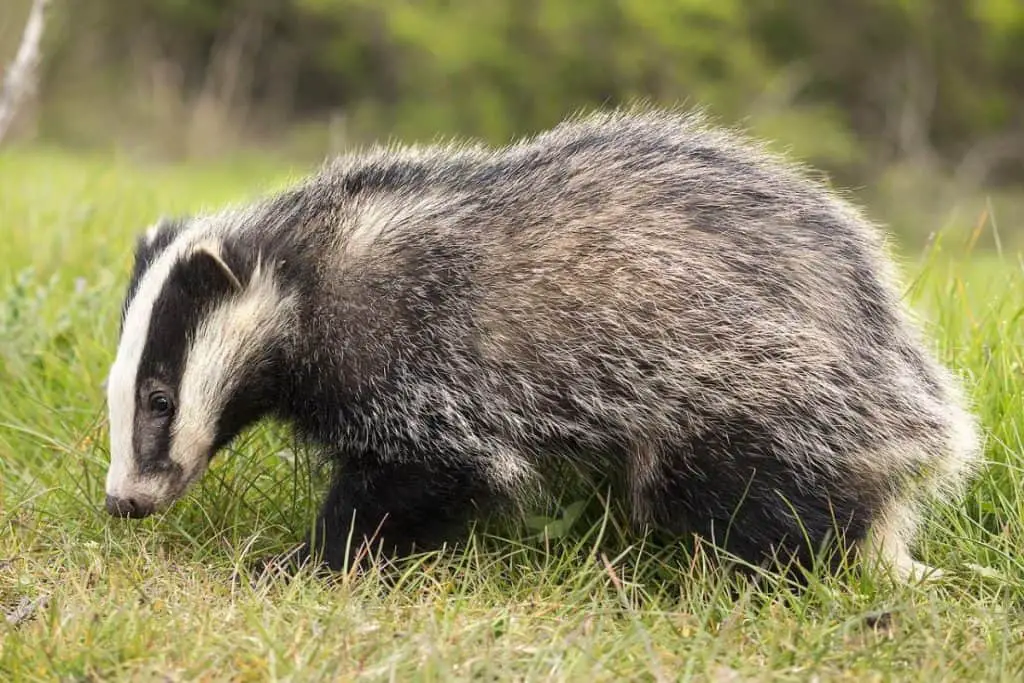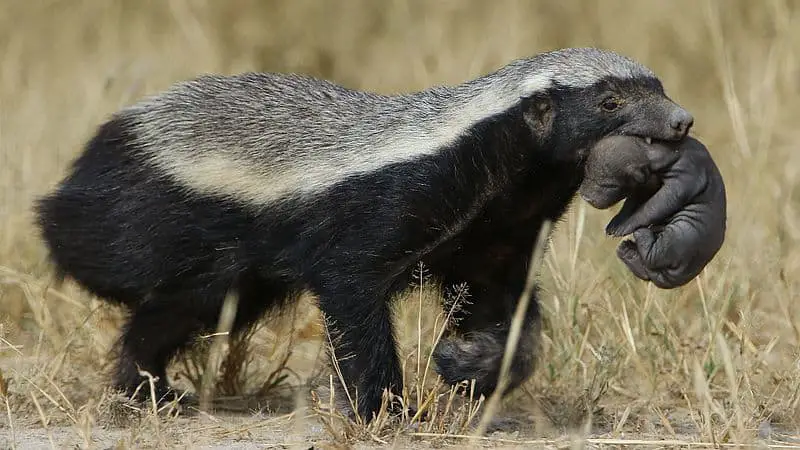You may have seen or heard of one species of badger in your area, but there are quite a few different species worldwide. In this article, I look at the different species and where you can find them.
There are fifteen badger species, including four Eurasian, six ferret badgers, three hog badger species, the honey badger, and the American badger. There are two species of stink badger, although these are now included in the skunk family.
Please read on if you want to know more about the different species of badgers.

Eurasian badgers
Four species of Eurasian badger make up the genus Meles. They were once thought to be a single species with three subspecies. Eurasian badgers include the Asian badger, Japanese badger, Caucasian badger, and European badger.
All four species have similar stocky bodies and small, black eyes. The largest Eurasian badger is the European badger. They share their characteristic black mask with the Caucasian badger.
They have short, black, white, brown, and grey fur. The Asian and Japanese badger are lighter in color than the western species, with the Japanese badger appearing brown.
They are nocturnal and will come out of their sett to feed after the sun has set. They are omnivores and opportunistic feeders. They feed mainly on insects, especially earthworms, but will feed on carrion, birds, and small mammals,
They live in burrows with multiple chambers and passages. More than one badger family may use the same setts in different years.
The Caucasian badger is similar to the European badger, although slightly smaller with a greyish color, rather than the black markings on European badgers. They have the typical face mask of the European badger.
The Asian badger is lighter in color than the European badger, with brownish stripes rather than black. They can be found in Russia, Kazakhstan, Mongolia, China, and Korea. There are five subspecies of Asian badger.
The Japanese badger is an endemic mammal to Japan. They can be found on Kyushu, Shikoku, Shodoshima, and Honshu, the largest island. They are classed as least concern as their population is decreasing.
They survive on a standard diet of earthworms and beetles and find local fruit such as persimmons and berries.
Do you know what badgers eat? Find out here
American badger
The American badger is the only extant badger in the genus Taxidiinae. The American badger had greyish-red upper parts with a white dorsal stripe extending to the tail from the shoulders.
They have black patches on the face and cheeks, while the chin and throat are white, giving them a masked appearance. They are short and stocky, with large foreclaws, bushy tails, and long fur.
They are excellent burrowers and can easily dig themselves out of sight when spotted. Their burrows can extend three meters below the surface and be up to ten meters long.
While American badgers stay in one area during winter, they may travel over 100 kilometers in summer.
Honey Badger
The honey badger is also known as the Ratel and is the only species in the genus Mellivora. The honey badger is more similar to weasels than other badger species.
The honey badger has exceptionally thick skin, up to 6mm thick, and honey badgers are almost impervious to stings, bites, and even porcupine quills due to their thick skin. Dog bites rarely get through the skin, although the belly is not as wide.
Should you feed badgers in your garden? Find out here

They have been seen to attack much larger animals, including lions and hyenas, and will defend their territory tirelessly. They have loose skin, and the honey badger can twist in its skin, allowing it to bite its attacker, even when attacked with a bite to the neck.
However, the honey badger is also a prey species, with the African leopard and African rock pythons feeding on them.
Hog badgers
There are three species of hog badger making up the genus Arctonyx. These are the Greater hog badger, the Northern hog badger, and the Sumatran hog badger.
All three species were initially classed as the Greater hog badger. This was changed in 2008, with all three becoming individual species.
The Greater hog badger is one of the largest, possibly second only in size to the European badger, and has two black stripes running down its face.
The Greater hog badger can be found in Thailand and Indochina, where it lives in evergreen forests and grasslands. Unlike most other badgers, the Greater hog badger is not strictly nocturnal and will come out daily to forage.
The Northern hog badger is smaller than the Greater hog badger and has longer fur. They can be found in northeast India and Bangladesh, and China.
They can be found around the central and northern provinces of China, with many people sighting them around the boundaries of Beijing. There are also unconfirmed sightings in other Asian countries.
They live at high altitudes up to about 4,500 meters. They are classed as least concern by the IUCN.
The Sumatran hog badger can only be found on the island of Sumatra, where they can be found at high altitudes. They live in the meadows and forests of Sumatra up to a height of 2,600 meters. Although they are limited to only one island, they are classified as least concern by the IUCN.
Stink badgers
Stink badgers are Old World relatives of skunks and are not closely related to true badgers. However, I have included them here because of their name.
There are two species of stink badger in the genus Mydaus; the Sunda stink badger and the Palawan stink badger.
The Sunda stink badger, also known as the Indonesian badger, Malay badger, and Javan stink badger, can be found over 2,100 meters. They are nocturnal, coming out of their holes in the ground which they sometimes share with porcupines.
They have shallow burrows, usually less the one meter deep. They also live in caves, especially in Borneo.
The Palawan stink badger can be found in the western Philippines in Palawan, Busuanga, and Calauit.
Although they were once classified as one of the smallest badgers, they are now one of the largest members of the skunk family, similar to the American badger. They are more similar in appearance to badgers than skunks.
The Palawan stink badger is nocturnal and eats a variety of crabs and small insects. They will travel up to 2km to find food and mark their territory using scents from anal glands, which they can spray up to one meter away.
Do you know what eats badgers? Find out here
Ferret badgers
The six species of ferret badgers make up the entire genus Melogale. Ferret badgers are usually found in wooded country and grassland.
They live in burrows and natural shelters and are nocturnal. They can often be seen climbing trees and sometimes sleeping on the branches.
They have warning markings on their heads, which are black with patches or yellow or white. They are fearless and aggressive, especially when provoked or threatened. They can also produce an offensive odor to deter predators.
Insects make up a large portion of their diet, including earthworms and beetles, although they will also eat fruit and small vertebrates.
All six species are similar in size and shape, with light to dark brown fur and white facial markings. The main differences between the species are their distribution.
The Burmese ferret-badger can be found in northeastern India, Bangladesh, Thailand, Myanmar, Nepal, Cambodia, China, Laos, and Vietnam.
The Javan ferret-badger can be found on the islands of Java and Bali in Indonesia.
The Chinese ferret-badger can be found from Northeast India through to Central China.
The Bornean ferret-badger can be found on the island of Borneo, which is classed as endangered by the IUCN.
The Vietnam ferret badger is very rare, with only two recorded species. Although both have died, the different coloration was enough for it to be assigned as a new species.
